CHAPTER 2
QUARTZ CRYSTAL CLARITY
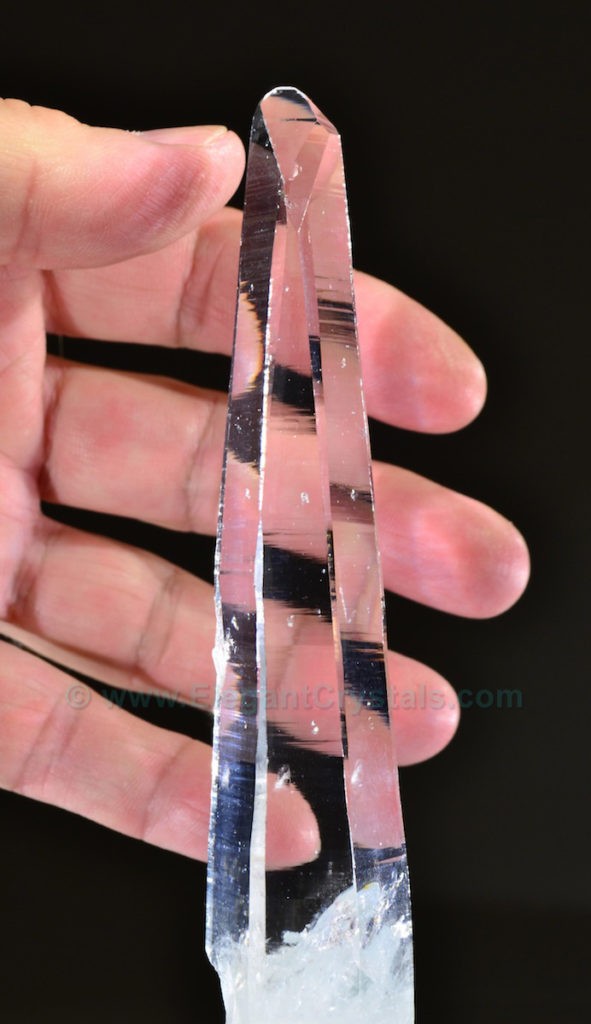
Picture #10
Five-inch-long Muzo, Colombia Clear Quartz Point
Quartz crystal caves and geodes contain clear crystals that can point outwards from every surface.
During mining, many individual crystals separate from the walls of the cave.
Ancient earthquakes sometimes loosen them, as do shocks from the mining process.
These single points can range from 1/4-inch-long to 20-feet-tall or more.
High quality crystals are glossy and look amazingly perfect once the dirt and rust are removed from their surfaces.
The flawless quartz crystal pictured above is 100% natural.
It was found in a mine near Muzo, Colombia.
While the crystal is less than an inch wide, it has an elegant elongated shape that tapers towards the tip.
It is so clear that it virtually disappears when you look at it.
Because of the refraction qualities of the quartz crystal, you can see that my fingers look disconnected and slightly shifted.
I deliberately photographed the crystal this way.
I wanted to show you both the extraordinary clarity and the high amount of refraction (light bending) that shifts the images inside.
We can see some striations (horizontal lines) on the surfaces.
Tiny, perfectly straight ridges of silica molecules form these growth lines on the outside of the crystal.

Picture #11
The Shadow of a Five-inch-tall Muzo, Colombia Quartz Single Point
In this second image of the same crystal, the parallel striations on the surface create a high contrast shadow.
These ridges produce shadows by angling some light away from the wall.
The extra light forms bright zones called interference patterns.
I think of these natural striations as “frequency filters” that tune a crystal to a specific person’s energy.
Each quartz crystal is unique, never to be duplicated in a billion years.
Quartz crystals can range from completely clear (also called “optically clear” or water clear) to opaque or solid white.
Microscopic bubbles of water, air or carbon dioxide cause mistiness or “milk” inside the stone.
Sometimes methane, petroleum, various oils or mineral particles can also be found in quartz.
These inclusions can move around inside cavities in the crystal.
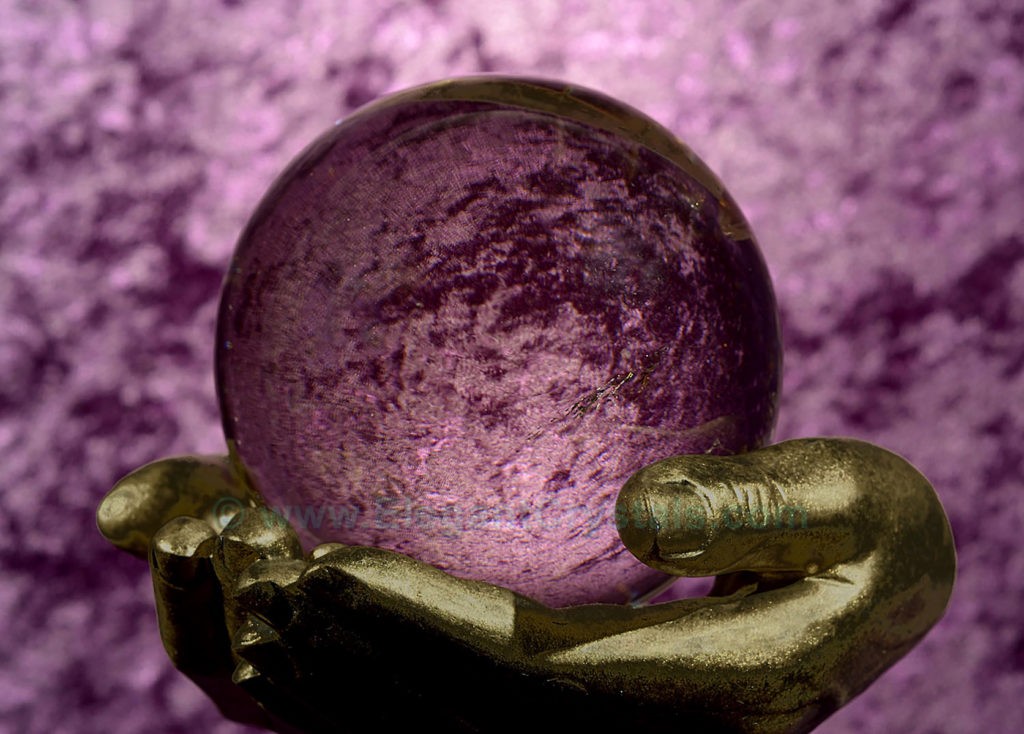
Picture #12
Optically Clear Natural Quartz Carved Into a Perfect Sphere
Degrees of Transparency in Quartz Crystals
Optical clarity is often called “water clear” quartz.
The crystal or gem has no visible inclusions to the unaided eye.
(Microscopes may show some tiny inclusions.)
Sadly, we seldom find a stone over four inches long that is water clear.
Occasionally a large perfect sphere can be successfully cut from a multi-ton crystal, yielding a 12-inch diameter globe of startling clarity.
Tons of milky quartz are cut away to reach the clear zone.
Prices can run into the hundreds of thousands of dollars for such a rare item.
Please note that with no inclusions, a flawless sphere looks exactly the same from every angle.
Some people like this; others prefer complex patterns or colorful shapes inside for variety.
Each of the 12 facets on a natural quartz crystal has its own unique shape and striations.
It may also have differences in the surface texture or contain layers of colorful particles trapped inside the quartz.
Unlike water clear spheres, faceted stones will always provide a variety of viewing experiences depending on how you look at the crystal.
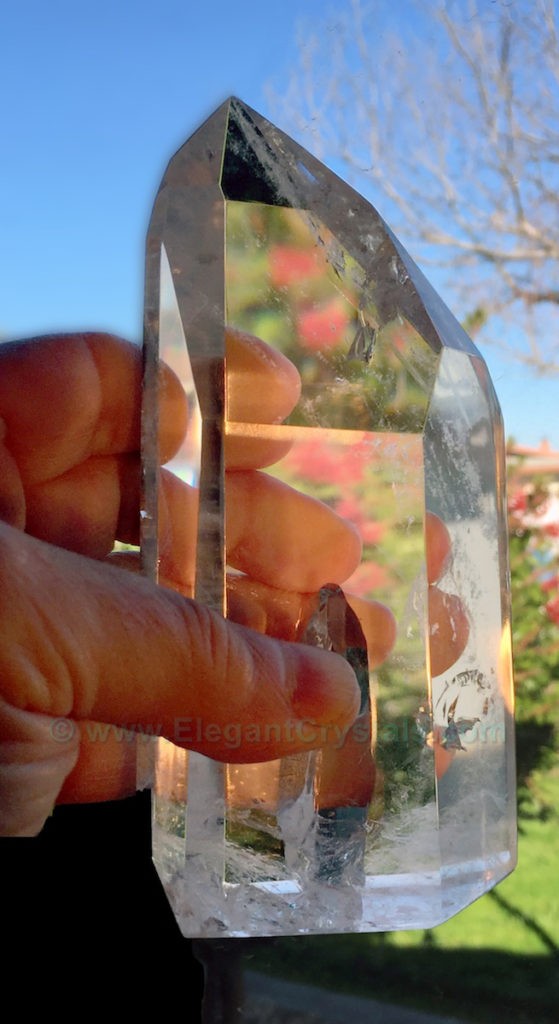
Picture #13
5-inch-tall Polished Brazilian Quartz
Showing “Fingerprint” Transparency
Transparent Zones and See Through Visibility
Most crystals will have areas, or zones, where you can see all the way through the piece.
You can use the “Hand Test,” as a quick way to determine clarity of a specimen.
How much of your hand can you see through the depth of the stone?
Can you see your fingerprints all the way through the gem?
The curve of a clear ball magnifies visibility.
You might be able to see great detail through a fine quality crystal ball.

Picture #14
14-inch-long Diamintina, Brazil Quartz Crystal
Transparent Zones into Part of the Crystal
A stone may have optically clear zones several inches deep that you can see into.
However, some types of inclusions will prevent see-through visibility.
(The “Hand Test” would not work here.)
This type of crystal displays well with bottom lighting.
Use white or colored light to enhance the beauty and visibility of the inclusions.
The crystal above comes from Diamantina, Brazil, home of the Lemurian crystals.
We will look at these in more detail soon.
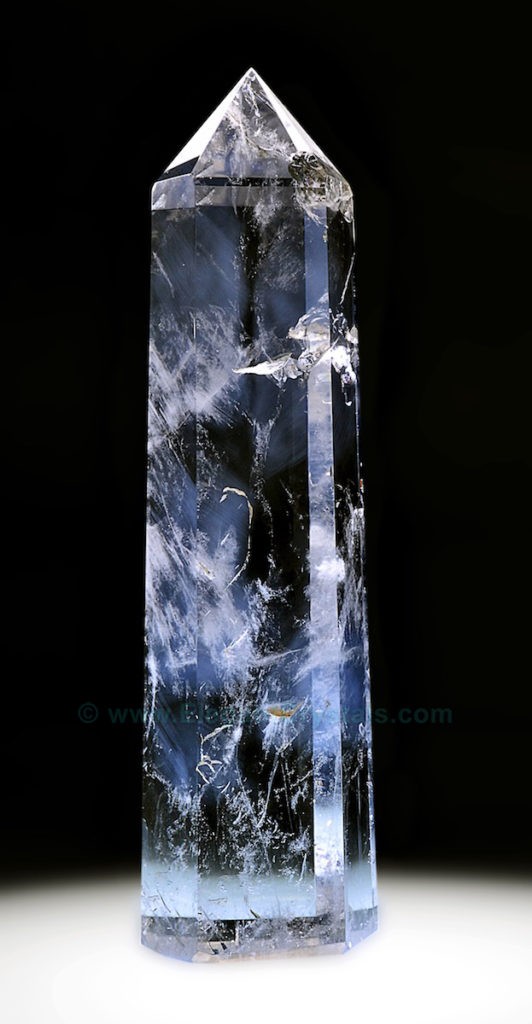
Picture #15
Polished Four-inch-tall Brazilian Quartz
with “Blue-Feather” Patterns
Misty and Milky Crystals
During crystal formation, there are liquids and gases mixed in with the molten stone.
Sometimes, the fluids are trapped as tiny bubbles in wave-like patterns within the quartz.
The visual density can range from very white, to nebulous veils, to a fine haze.
When a dense mist is opaque, the crystal is called “milky quartz.”
Milky crystals can be bottom lit or backlit and will glow nicely.
Misty crystals can be lit with spotlights from any direction for dramatic effects.
Misty crystals often show beautiful wave-like patterns resembling ocean surf and spray.
These “micro-bubbles” display the fluid waves of the ancient crystal’s growing environment.
“Vacuum gaps” also occur such as the crystal pictured here.
The “bubbles” don’t actually have anything in them.
They are more like tiny cracks containing space but no fluids.
These appear as blue zones due to the way the gaps reflect light rays. (The Tyndall Effect)
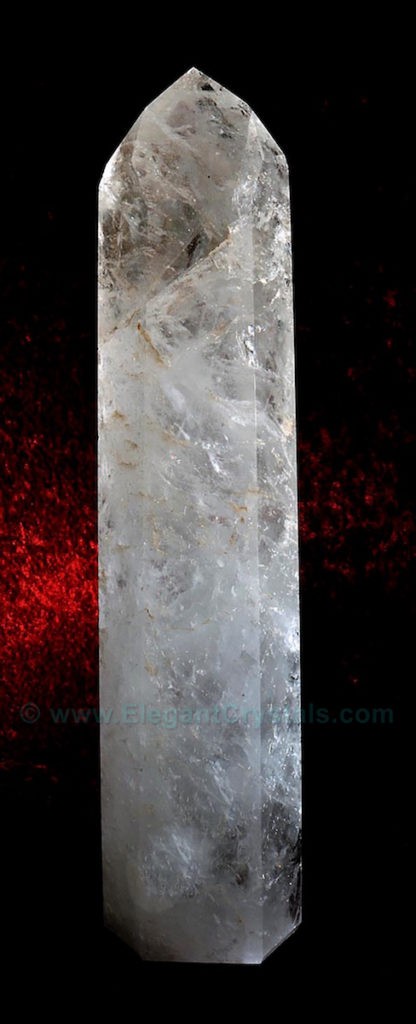
Picture #16
12-inch-tall Polished Milky Quartz From Brazil
Types of Bubble Inclusions
“Misty”: tiny semi-transparent bubbles.
“Milky”: solid white zones of dense microscopic bubbles.
“Enhydros”: large floating air bubbles inside water-filled pockets in quartz.
Amazingly enough, mistiness can change over time.
Back in 1983, I sold a small crystal to my friend Charles.
It was about two inches wide by five inches long.
When he bought this crystal, it was almost entirely white with a tiny clear zone near the tip.
I would say that no more than 10% of the crystal had any clarity.
The tip itself had an exceptionally long facet, which is sometimes called a “chisel point” because of the tool-shape it mimics.
This particular chisel point crystal was cracked and broken in the middle.
It was obviously missing a piece from the top of the crystal.
I remember I only charged Charles a few dollars because I was not too impressed by the quality of the stone.
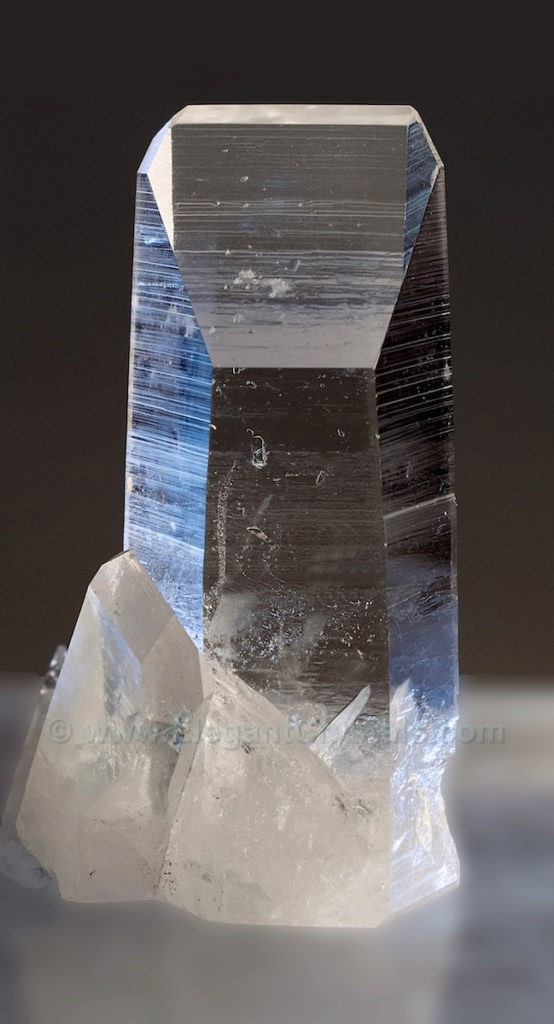
Picture #17
Crystal Bill’s Perfect 3-inch-tall Arkansas Chisel Point
Charles is a powerful energy worker.
He spent a year or more meditating with his crystal.
The next time I saw Charles, he was excited to tell me that the crystal had changed over the previous months.
He showed me how the white part of the crystal had turned transparent to the extent that almost 90% of the crystal had clarified.
That is truly some powerful energy work!
Then I looked at the edge of the chisel point on the tip.
I noticed that the broken area, which formerly had curved surfaces, now had little flat facets multiplying up towards the tip.
Every single part of the breakage had started re-growing and re-perfecting itself as flat triangular mirror-like surfaces.
I was astounded to see this.
It was the very first crystal that repaired itself with no help from a gem cutter.
This is the only time I witnessed the self-replicating qualities of the quartz atomic structure.
Did the crystal really facet itself?
I think so.
I just do not know how this little miracle occurred.
It is outside the bounds of known science.
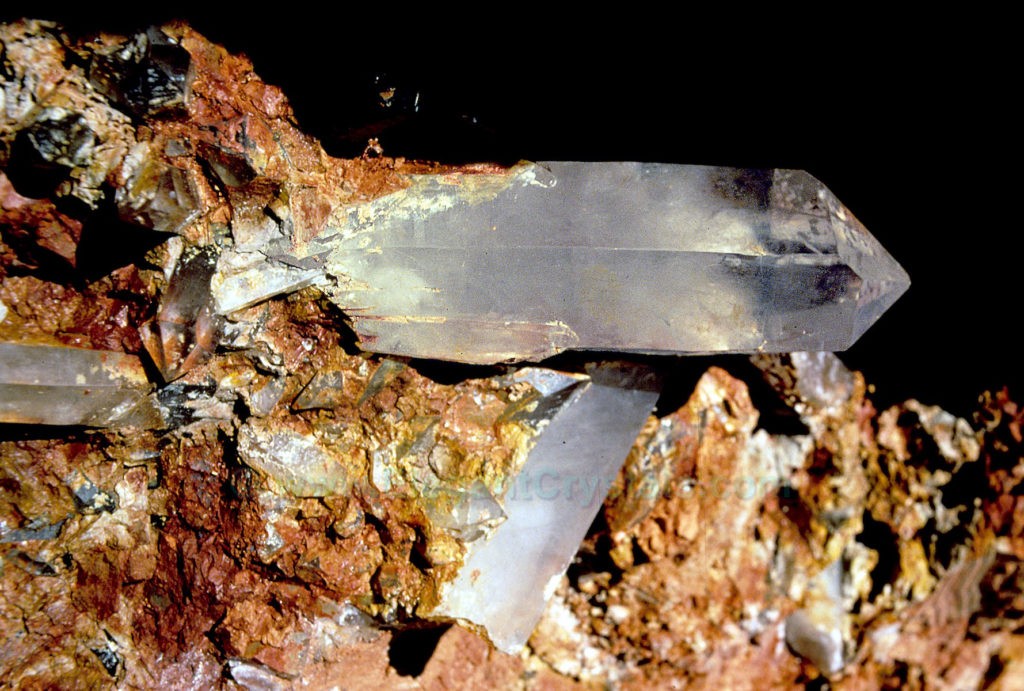
Picture #18
Six-inch-long Arkansas Crystal
Waiting To Be Harvested From The Ground
Most clear crystals have crusty mineral or mud deposits on them when they are in the ground.
In the picture above, you can see the intricate patterns and colors surrounding this Arkansas crystal.
Originally, the stone had a heavy brown deposit of clay coating on all its surfaces.
I wiped off the clay to get this picture before plucking the crystal from the earth.
In Brazil, dense coatings encourage lapidary artisans to polish the sides flat for a better view of the interior.
The bottom is often cut level and polished so the crystal can stand up vertically.
I call these “crystal towers” or “lighthouse crystals.”
They resemble Egyptian obelisks, which have four flat sides and a tiny pyramid at the tip.
The crystal towers have six flat sides, with a six-sided pyramid at the point.
These are elegant shapes for display on tables and altars.
The vertical presentation helps interconnect the energies of Heaven and Earth.
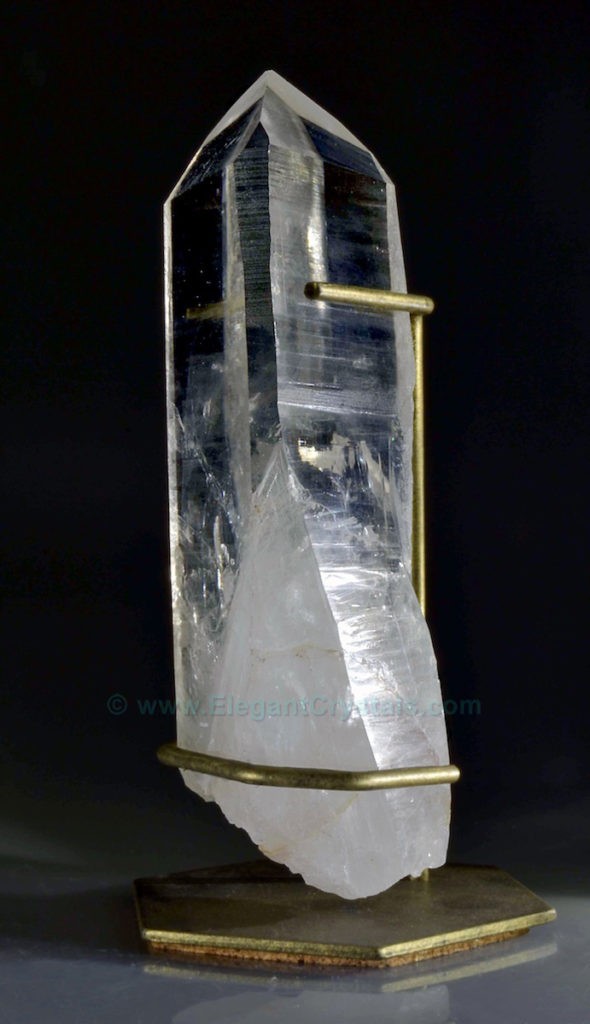
Picture #19
Ten-inch-tall Natural Brazilian Quartz Point,
Standing upright in a Custom Steel Stand
Lemurian crystals, like this one, come from the Diamantina region of Brazil.
These particularly fine, glossy clear crystals often taper inwards towards the tip.
Some of them are quite large, even two feet long.
This example is over ten inches tall.
Smaller single crystals make great “hand-holders” and healing tools.
When they are polished, they can be amazingly clear.
The Lemurian name comes from the relationship with Lemuria, an ancient civilization, properly known as Mu.
Mu is considered the legendary Garden of Eden, where all life existed in perfect balance and harmony.
Your Lemurian crystal can enhance your connection with this realm of Paradise.
